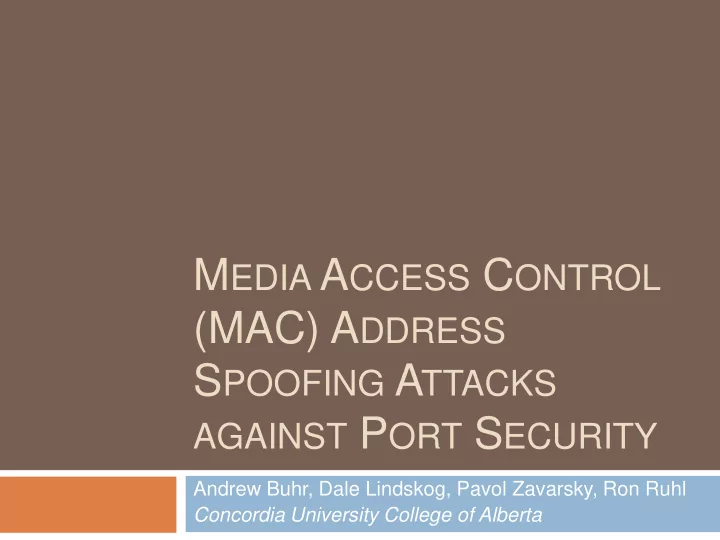

M EDIA A CCESS C ONTROL (MAC) A DDRESS S POOFING A TTACKS AGAINST P ORT S ECURITY Andrew Buhr, Dale Lindskog, Pavol Zavarsky, Ron Ruhl Concordia University College of Alberta
Findings Port Security is ineffective at preventing 3 different MAC Spoofing attacks in broadcast domains that span multiple switches. Port Security actually decrease the difficulty for 2 of these attacks.
Overview Background Switch learning process Port security Describe 2 attacks Details, ease and limitations Discuss 3 countermeasures Trunk port security Port security sticky Segregation mitigation strategy (recommended)
Not Covered in Presentation Third attack in a more sophisticated topology (Full MITM with three edge switches) Attack limitation details Reconnaissance Improving attack success
What is Cisco Port Security? Restrictive control applied to edge ports CAM overflow attacks -> MAC address spoofing Source MAC address compared to other learnt addresses
Non-secure Switch Learning Process Source MAC learning 1:N(int-MAC) Aging
Secure Switch Learning Process Secure source MAC learning Non-aging Precedence
Interswitch Connections
MAC Spoofing
Port Security - Violation Condition (1) “The maximum number of secure MAC addresses have been added to the address table, and a station whose MAC address is not in the address table attempts to access the [secure] interface” - Cisco Mitigates CAM overflow attacks Caveats (in regards to MAC spoofing) Legitimate MAC – no mechanism Immediate registration – no mechanism
Port Security - Violation Condition (2) “An address learned or configured on one secure interface is seen on another secure interface in the same VLAN” - Cisco Mitigates MAC Spoofing Applies only when both interfaces are secure
Port Security Best Practices Enterprise Environment For a “dynamic environment, such as an access edge, where a port may have port security enabled with the maximum number [secure] MAC addresses set to one, enable only one [secure] MAC address to be dynamically learnt ay any one time” – Cisco
Assumptions (1) Attacker hasn’t registered MAC; Or can unplug cable (clear secure MAC entry) Sticky – more later (2) No port security on interconnecting interfaces Against best practices More later We assume full network knowledge Covered in limitations section
Attack #1 – Impersonation (initial) Port Security enabled on edge ports A listens for an ARP-Request V1 -> V2 V2 replies to V1 E1 MAC Address Table (initial): VLAN MAC Addr Type Ports Secure 1 V1 DYNAMIC Fa0/1 Yes 1 V2 DYNAMIC Gi0/1 No
Attack #1 (resulting) A replays V2 exect ARP-Reply to update MAC address table No violation is thrown because initial V2 entry was non-secure and secure entries take precedence E1 MAC Address Table (resulting): VLAN MAC Addr Type Ports Secure 1 V1 DYNAMIC Fa0/1 Yes 1 V2 DYNAMIC Fa0/2 Yes All frames V1 -> A A cannot -> V2
Attack #1 (ease – no port security) Race condition introduced: If A replays V2 ARP-Reply, then E1 MAC Address Table will show V2 on Fa0/2 But If V2 tries to communicate with any node on E1 , then V2 will switch back to Gi0/1 on E1 MAC table updates on last observed basis Port security locks in the MAC
Attack #1 (limitations) A cannot impersonate directly connected node - violation A cannot impersonate 2 indirectly connected nodes Can impersonate ½ network nodes and ¼ of total communication streams A V1 V2 Result E1 E1 E1 Port security violation E1 E1 E2 Impersonate V2 ( V1 perspective) E1 E2 E1 Impersonate V1 ( V2 perspective) E1 E2 E2 No port security violation
Attack #2 – Full MITM Additional switch access A replays ARP-Reply out Fa0/2 on E1 to poison E1 (same as Attack #1) A then replays ARP- Request out Fa0/2 on E2 to poison E2 Removes limitation of spoofing directly connected nodes (attack victims doubled)
Attack #2 (cont.) May be detected because ARP-Reply is unsolicited (could be blocked) Attack is more difficult without port security because race conditions exit on both sides ½ of communication streams (no direct to direct)
Defences and Countermeasures (1) (1) Interconnecting Switch Port Security Would span secure entries across broadcast domain Etherchannel is not supported STP is not interoperable Topology change – different ports Node relocation problems No deregistration mechanism (distribution lock) Increased risk to infrastructure
Defences and Countermeasures (2) (2) Port Security Sticky More difficult to spoof if address already registered Node relocation problems Deliver to wrong port Manual change process control Undermines dynamic benefit of switch learning process
Defences and Countermeasures (3) (3) Segregate broadcast domains based on trust and role Ideal to de-span all broadcast domains Prevents attacks But logical grouping is sometimes required Flexibility Cost Performance
Defences and Countermeasures (3) Segregate trusted from untrusted Then they can’t attack each other Nodes Trusted Untrusted Mobile/Temp Servers Clients Clients
Defences and Countermeasures (3) Segregate untrusted nodes from untrusted nodes They are the most likely to attack Segregate trusted based on role (client or server) Trusted clients can still span Trusted servers can either span or not Implement sticky when they span
Recommend
More recommend